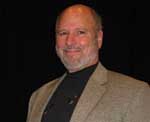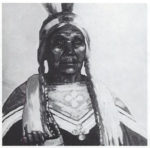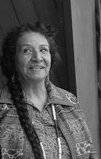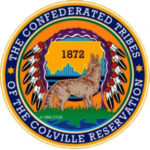Lucy Friedlander Covington was extraordinary. Her grandfather Herman Friedlander was Jewish and her grandmother an Entiat tribal woman. According to Lucy, neither of the couple learned the other’s language, so their seven children spoke both Jewish/German and Entiat. –– Charles Trimble, Oglala Lakota
By Jerry Klinger

Attending a Shiva House a few weeks back, a tall, orthodox Jew began chanting the Kaddish in memory of his departed mother. He chanted neither with a Sephardic accent nor with an Ashkenazic accent. He chanted with an accent toned with the hills of Kentucky. His mother had been a stalwart in her Kentucky Jewish community. Many years earlier, she left Brooklyn to live with her husband, a 100% Choctaw Indian, in Kentucky. Her husband attended synagogue services with her. They raised their family as Jews, orthodox Jews. He never converted or separated from his heritage and roots, nor did she. Each respected and honored the other’s heritage.
As the American frontier moved Westward, Jews were part of the story. They certainly were not in the huge numbers of the non-Jews but the Tribe was there. Jews were frontiersman, wagon train masters, explorers, soldiers, merchants, gunslingers, hookers, ranchers, farmers, merchants, Indian fighters and even an Indian Chief. Yes, a nice Yiddishe Boy, who could not speak English, became “Chief of the Acoma” Indians.
The Tribe was well represented on the Frontier. Understandably, there were not many nice, eligible Jewish girls to choose from. It was not uncommon for Members of the Tribe to intermarry with non-Tribal ladies or even the ladies of other Tribes, namely Native Americans.
Joseph Herman Friedlander was a Jew of German background. He ran a small military and Indian trading post near remote Camp Chelan on the Eastern edges of the Cascade Mountains at the mouth of Lake Chelan, Washington. Camp Chelan had been created, as many such small military outposts had been created in the 1880’s, to keep an eye on the Indians on reservation land. The Indians called Friedlander, Peranik.

Skn-wheulks
(Elizabeth Friedlander) Photo: Courtesy of the Maryhill Museum
Skn-wheulks, (Sken-What-Ux) was the daughter of the chief of the Entiat tribe. Skn-wheulks was baptized Elizabeth by Father Urban Grassi, the Italian Jesuit Missionary to the Entiats. She was a beautiful woman.
Maybe it was love, or perhaps lust, at first sight for the lonely Jewish merchant when Friedlander first saw her outside his trading post. He immediately approached Elizabeth’s chaperone, her Uncle, and proposed his intention to marry her. On their ride home, Elizabeth’s Uncle told her about the proposal.
Weighing an alternate Indian marriage, Elizabeth accepted Friedlander’s offer instead.
Not wasting a moment, Friedlander and Elizabeth were married by the first Justice of the Peace available.
The Friedlander’s had seven children. It was an interesting relationship since neither could speak the other’s language. Friedlander died suddenly leaving Elizabeth with small children. Reluctantly, the children were sent to Government Indian schools where civilizing was the principle preoccupation. Their religion had already been appropriated and replaced. The transmission of Indian culture, even the speaking of their Native Indian language, was severely repressed. The school worked hard at removing the Native from the Indian.
The Native American/Jewish Friedlander blood line knew religious oppression. 2,200 years earlier, Antiochus IV Epiphanes, King of the Seleucid Syrians conquerors of Israel, forbade Jewish religious practice. The Jews successfully revolted. Today, that victory for Jewish religious freedom is celebrated as Hannukah.
Jewish self-rule and freedom did not last long. 66 AD the Romans conquered the Land and four years later destroyed the center of the Jewish life, the Temple in Jerusalem. By 135, Emperor Hadrian, fed up with the Jews after another revolt, changed the name of Israel (the Roman province of Judaea) to Syria Palaestina (Palestine). He changed the name of Jerusalem to Aelia Capitolina. The Jews were exiled. The Romans wanted to erase forever the historical ties of the Jewish people to their Land.
The Romans failed as did every oppressor of Jews since.
For most Jews, spread out in the Diasporas of the Muslim and Christian world, memory and longing were their principle connection to the Land. Yet, there always remained a small minority of Jews who refused to leave their Land. Despite wave upon wave of oppressors, over 1800 years, the small, minority maintained the continuity of Jewish presence on the Land until the birth of the modern State of Israel in 1948.
The Friedlander children rebelled at school. They tried to run away. After a short few years, the children returned to the reservation for their education and lives. Once again, home, on their own land, their language and culture was reasserted. The memory of White society trying to destroy the ties of the Friedlander children to their land and their culture never left them.

One of their children was a girl named Nellie. She married a fellow Colville member. The couple settled down, choosing to remain on the Reservation, on the Land. One of their daughters, they named Lucy. She was the fourth of five children. Lucy was born in a teepee in the small Colville Reservation town of Nespelem, November 24, 1910.
The extended family lived close to one another on family land. Lucy absorbed the lessons her maternal great-Aunt Mary taught to her and all the children. “She wanted me to know somehow how much suffering had happened before we got a home base.’ Her take-away? ‘ If an Indian doesn’t have land, he has nothing”, Lucy told an interviewer years later.
When Lucy was 25, she married John Covington, also a Native American. Honoring her family heritage, she kept her family name and became Lucy Friedlander Covington. The young couple lived on and off the reservation, moving around, looking for work. World War II, both John and Lucy took work as welders in an Oregon shipyard. Lucy remained in Portland at her welding job when John joined the Navy.
With the war’s conclusion, Lucy and John returned to the Reservation. They took up ranching on Lucy’s family land. Never having had children of their own, their lives remained full taking care of the ranch and helping supervise an expanding world of nieces and nephews. It might have remained that way except the government in Washington had another idea. It was not directed at Lucy or the Colville Reservation Native Americans in particular. It was directed at all Native Americans nationwide.
Indian relations with American Colonial governments, and later the Federal government, were conflicted. Land was always the issue as the expanding demands for land and settlement pushed against the Native American presence and treaty titles to the land. The Colonial and the Federal governments, at times, tried to honor their treaty obligations with Native Americans. For the most part, they failed.
“Die Juden sind unser Unglück!”, the Jews are our misfortune, anti-Semite Heinrich von Treitschke lamented in the 1880’s. The sentiment on the American frontier of huge waves of opportunistic immigrants were not much different, the Indians are our misfortune. The Indians could say the same thing – the White Man is our misfortune.
Federal Government Native American policy evolved from coexistence (1789-1828), to removal and reservations (1829–86), assimilation (1887-1932), reorganization (1932–45), and Termination, beginning in 1946, for Lucy and John when they moved back to the Reservation.
The Government believed by terminating its trusteeship of Indian lands and encouraging Indians to move to the cities, that education, employment and assimilation would finally bring an end to the difficult saga and terrible Reservation conditions that characterized much of Native American experience. To achieve Termination, the Federal government was prepared to pay. For some of the very small Tribes, such as were on the Colville Reservation, the monies were very significant.
 Lucy was elected to the Colville Tribal Council in the early 1950s. At a Council meeting, she learned that the Colville Tribal Council, faced with a future of poverty, desperation and societal decay, had voted to begin the process of Termination.
Lucy was elected to the Colville Tribal Council in the early 1950s. At a Council meeting, she learned that the Colville Tribal Council, faced with a future of poverty, desperation and societal decay, had voted to begin the process of Termination.
Lucy was alone in the Council, horrified at the loss of the Tribal lands, at the surrender of the Tribe’s patrimony and the destruction of her people. With her spirit inflamed, she began a lonely quest. Slowly, steadily she changed one vote after another on the Tribal Council until a majority was against Termination. However, the policy of Termination remained national Indian policy.
Over the next fifteen years, Lucy drove herself, burning with mission for her Tribe, for all Native Americans, to fight Termination. She spoke to anyone, anywhere. She repeatedly traveled to Washington, having sold her own cattle to raise the funds, lobbying, buttonholing anyone she could.
1970, President Richard Nixon formally ended the policy of Native American Termination and replaced it with Self-Determination. Trusteeship of the land was returned to the Tribes. Lucy had won for the Confederated Tribes of the Colville Reservation.
2007, U.S. Senator Ben Nighthorse Campbell, himself a Northern Cheyenne, described the Termination policy. “If you can’t change them, absorb them until they simply disappear into the mainstream culture. …In Washington’s infinite wisdom, it was decided that tribes should no longer be tribes, never mind that they had been tribes for thousands of years.”
Lucy won for all Native Americans. Lucy Friedlander Covington won for all Americans.
Lucy died September 22, 1982, one with the land she had fought so hard to protect for her people and posterity. She was buried in the Nespelem Cemetery, not far from the resting place of famed Chief Joseph of the Nez Perce.
Jews have a long history of supporting the Native American struggle. During the early years of the Native American movement, it was estimated that 80% of the lawyers defending the protesters at Wounded Knee in 1973, were Jews.
April, 2014, the Native American and Indigenous Studies Association voted to support the Palestinian inspired Boycott, Divestment and Sanctions (BDS) anti-Israel movement. The BDS movement has morphed with a rabid infusion of anti-Semitism imbued with an active denial of the Jewish relationship to the Land of Israel. 2016, the United Nations voted, in active support of the Palestinians, that the Temple Mount in Jerusalem has no connection to the Jews. Denying the Jewish relationship to the Temple Mount, the U.N. has denied to Christians the historical legitimacy of Jesus to Jerusalem and the Temple Mount .
Native Americans are far from monolithic in their political and social views. Many disagree with the BDS anti-Israel views. JASHP is working with Eastern Washington State University to place a historic interpretive roadside marker to honor Lucy Friedlander Covington.
*
Jerry Klinger is president of the Jewish American Society for Historic Preservation
Fascinating story. Many thanks for sharing.